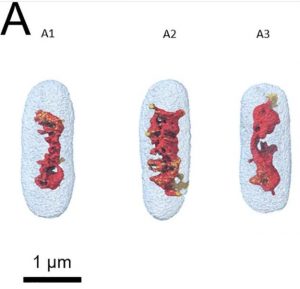Antoine Cossa, Sylvain Trépout, Frank Wien, Johannes Groen, Etienne Le Brun, Florian Turbant, Laetitia Besse, Eva Pereiro, Véronique Arluison
The bacterial chromosomic DNA is packed within a membrane-less structure, the nucleoid, due to the association of DNA with proteins called Nucleoid Associated Proteins (NAPs). Among these NAPs, Hfq is one of the most intriguing as it plays both direct and indirect roles on DNA structure. Indeed, Hfq is best known to mediate post-transcriptional regulation by using small noncoding RNA (sRNA). Although Hfq presence in the nucleoid has been demonstrated for years, its precise role is still unclear. Recently, it has been shown in vitro that Hfq forms amyloid-like structures through its C-terminal region, hence belonging to the bridging family of NAPs. Here, using cryo soft X-ray tomography imaging of native unlabeled cells and using a semi-automatic analysis and segmentation procedure, we show that Hfq significantly remodels the Escherichia coli nucleoid. More specifically, Hfq influences nucleoid density especially during the stationary growth phase when it is more abundant. Our results indicate that Hfq could regulate nucleoid compaction directly via its interaction with DNA, but also at the post-transcriptional level via its interaction with RNAs. Taken together, our findings reveal a new role for this protein in nucleoid remodeling in vivo, that may serve in response to stress conditions and in adapting to changing environments.
https://doi.org/10.1016/j.jsb.2022.107912



